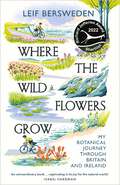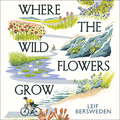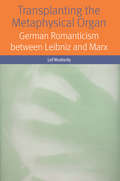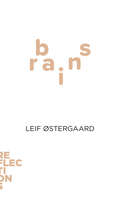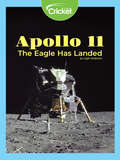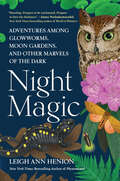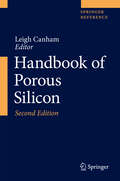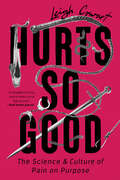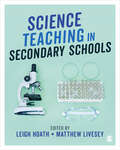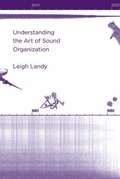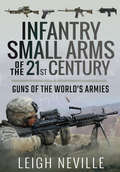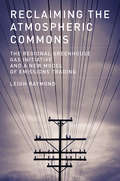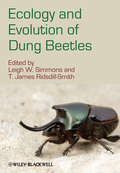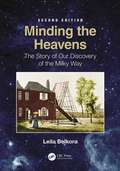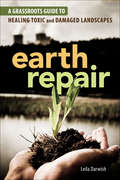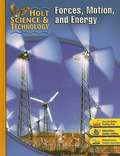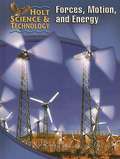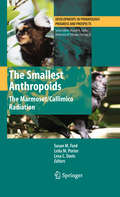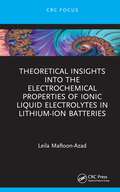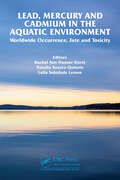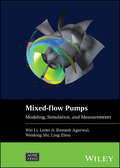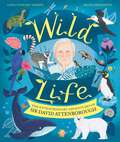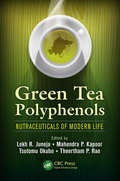- Table View
- List View
Where the Wildflowers Grow: My Botanical Journey Through Britain and Ireland
by Leif Bersweden'This bicycle Odyssey of Britain and Ireland's wild flora is joyous, inspirational and beautifully observed.' - Peter Marren, author of After They've Gone'The Wildflowers of Britain have a new champion.' - Lee Schofield, author of Wild Fell'A heart-warming, fascination-inducing read from start to finish.' - Lucy Lapwing'An extraordinary book... captivating in its joy for the natural world.' - Isabel Hardman'When was the last time you stopped and noticed a wild plant?'An intriguing and timely exploration of the importance of Britain and Ireland's plant life.Leif Bersweden has always been fascinated by wild plants. From a young age, his afternoons were spent hunting for and cataloguing the plants in his local area. But it is a landscape that is fast disappearing.Climate change, habitat destruction and declining pollinator populations mean that the future for plant life looks bleaker than ever before. Many of us are also unable to identify, or even notice, the plants that grow around us.Now a botanist, Leif decides to go on a mission, to explore the plants that Britain and Ireland have to offer and to meet those who spend time searching for them. Over the course of a year, Leif goes on a journey around the UK and Ireland, highlighting the unique plants that grow there, their history and the threats that face them. His journey takes him from the Cornish coast to the pine forests of Scotland - even to the streets of London, proving that nature can be found in the most unexpected places. Along the way, Leif highlights the joy and positivity that can be found through understanding nature and why it is so desperately important to protect our wildflowers.
Where the Wildflowers Grow: My Botanical Journey Through Britain and Ireland
by Leif Bersweden'When was the last time you stopped and noticed a wild plant?'An intriguing and timely exploration of the importance of Britain and Ireland's plant life.Leif Bersweden has always been fascinated by wild plants. From a young age, his afternoons were spent hunting for and cataloguing the plants in his local area. But it is a landscape that is fast disappearing.Climate change, habitat destruction and declining pollinator populations mean that the future for plant life looks bleaker than ever before. Many of us are also unable to identify, or even notice, the plants that grow around us.Now a botanist, Leif decides to go on a mission, to explore the plants that Britain and Ireland have to offer and to meet those who spend time searching for them. Over the course of a year, Leif goes on a journey around the UK and Ireland, highlighting the unique plants that grow there, their history and the threats that face them. His journey takes him from the Cornish coast to the pine forests of Scotland - even to the streets of London, proving that nature can be found in the most unexpected places. Along the way, Leif highlights the joy and positivity that can be found through understanding nature and why it is so desperately important to protect our wildflowers.(P) 2022 Hodder & Stoughton Limited
Transplanting the Metaphysical Organ: German Romanticism between Leibniz and Marx (Forms of Living)
by Leif WeatherbyAround 1800, German romanticism developed a philosophy this study calls “Romantic organology.” Scientific and philosophical notions of biological function and speculative thought converged to form the discourse that Transplanting the Metaphysical Organ reconstructs—a metaphysics meant to theorize, and ultimately alter, the structure of a politically and scientifically destabilized world.
Brains
by Leif ØstergaardA short but engaging exploration of the brain.In Brains, scientist Leif Østergaard explores our most complicated and mysterious organ. From the dissection of Einstein's brain to research on how to map networks of neurons, Østergaard deconstructs the different parts of the brain and provides an engaging overview of its essential functions. He explains how we store information in the synapses of neural networks and how these networks carry commands to our muscles and internal organs and receive sensory input from our skin, eyes, ears, nose, and mouth. Delving into the subconscious, we learn what our brains are doing while we daydream and how neurotransmitters play a role in addiction. In this fascinating book, Østergaard reveals how this enigmatic organ is even more complex than we thought it was.In Reflections, a series copublished with Denmark's Aarhus University Press, scholars deliver 60-page reflections on key concepts. These books present unique insights on a wide range of topics that entertain and enlighten readers with exciting discoveries and new perspectives.
Apollo 11: The Eagle Has Landed
by Leigh AndersonHave you ever looked into the night sky and wished that you could walk on the Moon? Find about what it is like from the astronauts that were first to do it! Learn about how Neil Armstrong, Edwin Aldrin, and Michael Collins traveled into space and created history in 1969, and what it was like to take those famous first steps that made “one giant leap for mankind."
Night Magic: Adventures Among Glowworms, Moon Gardens, and Other Marvels of the Dark
by Leigh Ann HenionFrom a New York Times bestselling nature writer comes a celebration of what goes on outside in the dark, from blooming moon gardens to nocturnal salamanders, from glowing foxfire and synchronous fireflies that blink in unison like an orchestra of light. In this glorious celebration of the night, New York Times bestselling nature writer Leigh Ann Henion invites us to leave our well-lit homes, step outside, and embrace the dark as a profoundly beautiful part of the world we inhabit. Because no matter where we live, we are surrounded by animals that rise with the moon, and blooms that reveal themselves as light fades. Henion explores her home region of Appalachia, where she attends a synchronous firefly event in Tennessee, a bat outing in Alabama, and a moth festival in Ohio. In North Carolina, she finds forests alight with bioluminescent mushrooms, neighborhood trees full of screech owls, and valleys teeming with migratory salamanders. Along the way, Henion encounters naturalists, biologists, primitive-skills experts, and others who&’ve dedicated their lives to cultivating relationships with darkness. Every page of this lyrical book feels like an opportunity to ask: How did I not know about this before? For example, we learn that it can take hours, not minutes, for human eyes to reach full night vision capacity. And that there are thousands of firefly species on earth, many with flash patterns as unique as fingerprints. In an age of increasing artificial light, Night Magic focuses on the amazing biodiversity that still surrounds us after sunset. We do not need to stargaze into the distant cosmos or dive into the depths of oceans to find awe in the dark. There are dazzling wonders in our own backyards. And readers of World of Wonders, Entangled Life, and The Hidden Life of Trees will discover joy in Night Magic.
Handbook of Porous Silicon
by Leigh CanhamThis handbook updates the most fast-moving research areas of porous silicon research, introduces a range of brand new topics not reviewed before and is even more inclusive of worldwide centres of expertise. Rapid advances are being made in porous silicon anodes for lithium batteries, biodegradable nanoparticles and nanoneedles for medical therapy and imaging, energetics and bio-diagnostic techniques. A number of additional characterization and processing techniques are also reviewed for the first time. Experts from 10 additional countries are involved in the 2nd edition: China, Vietnam, Singapore, Malaysia, Saudi Arabia, Turkey, Netherlands, Switzerland, Belarus, and Brazil, making more than 40 countries in total. The handbook therefore covers expertise from every continent. Another new feature is a review dedicated to industrial activity. This second edition endeavours to provide the community with a truly comprehensive database and up-to-date commentary on this versatile nanostructured material.
Hurts So Good: The Science and Culture of Pain on Purpose
by Leigh CowartAn exploration of why people all over the world love to engage in pain on purpose--from dominatrices, religious ascetics, and ultramarathoners to ballerinas, icy ocean bathers, and sideshow performersMasochism is sexy, human, reviled, worshipped, and can be delightfully bizarre. Deliberate and consensual pain has been with us for millennia, encompassing everyone from Black Plague flagellants to ballerinas dancing on broken bones to competitive eaters choking down hot peppers while they cry. Masochism is a part of us. It lives inside workaholics, tattoo enthusiasts, and all manner of garden variety pain-seekers. At its core, masochism is about feeling bad, then better—a phenomenon that is long overdue for a heartfelt and hilarious investigation. And Leigh Cowart would know: they are not just a researcher and science writer—they&’re an inveterate, high-sensation seeking masochist. And they have a few questions: Why do people engage in masochism? What are the benefits and the costs? And what does masochism have to say about the human experience? By participating in many of these activities themselves, and through conversations with psychologists, fellow scientists, and people who seek pain for pleasure, Cowart unveils how our minds and bodies find meaning and relief in pain—a quirk in our programming that drives discipline and innovation even as it threatens to swallow us whole.
Science Teaching in Secondary Schools
by Leigh Hoath Matthew LiveseyThis book is your essential guide to secondary science teacher training and the early career years giving smart, practical advice on developing your classroom skills and deepening your knowledge of science education. Covering all major aspects of science teaching, including: planning and assessment, the power of subject knowledge, teaching tricky topics and health and safety in class and lab work, it will encourage you to develop an informed approach to allow you to shine as an early career teacher of science. Key features: · Real life examples of how important teaching principles work in practice · What to look for when observing others teaching · Reflective questions challenging you to engage with key ideas · Chapters linked to the Core Content Framework and Early Career Framework Leigh Hoath is a Senior Professional Practice Fellow at Leeds Trinity University. Matthew Livesey is a teacher of biology at Bradford Grammar School.
Science Teaching in Secondary Schools
by Leigh Hoath Matthew LiveseyThis book is your essential guide to secondary science teacher training and the early career years giving smart, practical advice on developing your classroom skills and deepening your knowledge of science education. Covering all major aspects of science teaching, including: planning and assessment, the power of subject knowledge, teaching tricky topics and health and safety in class and lab work, it will encourage you to develop an informed approach to allow you to shine as an early career teacher of science. Key features: · Real life examples of how important teaching principles work in practice · What to look for when observing others teaching · Reflective questions challenging you to engage with key ideas · Chapters linked to the Core Content Framework and Early Career Framework Leigh Hoath is a Senior Professional Practice Fellow at Leeds Trinity University. Matthew Livesey is a teacher of biology at Bradford Grammar School.
Understanding the Art of Sound Organization
by Leigh LandyThe first work to propose a comprehensive musicological framework to study sound-based music, a rapidly developing body of work that includes electro-acoustic art music, turntable composition, and acoustic and digital sound installations.
Infantry Small Arms of the 21st Century: Guns of the World's Armies
by Leigh NevilleThe author of Guns of the Special Forces 2001-2015 presents a comprehensive overview of 21st century military guns used by small armies around the world. Soldiers in today's modern armies have access to ever more advanced infantry weapons; lighter, more compact and more accurate than anything seen in the last century. These include combat pistols, personal assault rifles, submachine guns, sniper rifles, shotguns, light machine guns and squad automatic weapons. Infantry Small Arms of the 21st Century features all these weapons and more, examining each in exhaustive detail. The author draws on the operational combat experience of the users in war zones such as Iraq, Afghanistan and Ukraine. As well as assessing and comparing the potency of different nations weapon systems, the book looks to the future demands of the infantry man.
Infantry Small Arms of the 21st Century: Guns of the World's Armies
by Leigh NevilleThe author of Guns of the Special Forces 2001-2015 presents a comprehensive overview of 21st century military guns used by small armies around the world. Soldiers in today's modern armies have access to ever more advanced infantry weapons; lighter, more compact and more accurate than anything seen in the last century. These include combat pistols, personal assault rifles, submachine guns, sniper rifles, shotguns, light machine guns and squad automatic weapons. Infantry Small Arms of the 21st Century features all these weapons and more, examining each in exhaustive detail. The author draws on the operational combat experience of the users in war zones such as Iraq, Afghanistan and Ukraine. As well as assessing and comparing the potency of different nations weapon systems, the book looks to the future demands of the infantry man.
Reclaiming the Atmospheric Commons: The Regional Greenhouse Gas Initiative and a New Model of Emissions Trading (American and Comparative Environmental Policy)
by Leigh RaymondHow the Regional Greenhouse Gas Initiative created a new paradigm in climate policy by requiring polluters to pay for their emissions for the first time.In 2008, a group of states in the northeast United States launched an emissions trading program, the Regional Greenhouse Gas Initiative (RGGI). With RGGI, these states—Connecticut, Delaware, Maine, Maryland, Massachusetts, New Hampshire, New Jersey, New York, Rhode Island, and Vermont—achieved what had been considered politically impossible: they forced polluters to pay the public for their emissions. The states accomplished this by conducting auctions of emissions “allowances”; by 2014, they had raised more than $2.2 billion in revenues. In this first in-depth examination of RGGI, Leigh Raymond describes this revolutionary and influential policy model and explains the practical and theoretical implications for climate policy.Other cap-and-trade schemes had been criticized for providing private profits rather than public benefits, allowing private firms to make money by buying and selling valuable “rights to pollute.” RGGI, by contrast, directed virtually all emissions auction revenues to programs benefiting the public at large. By reframing the issue in terms of public benefits, environmental advocates emphasized the public ownership of the atmospheric commons and private corporations' responsibility to pay for their use of it.Raymond argues that this kind of “normative reframing” is significant not only for environmental policy making but also for theories of the policy process, helping to explain and predict sudden policy change.
Ecology and Evolution of Dung Beetles
by Leigh W. Simmons T. James Ridsdill-SmithThis book describes the evolutionary and ecological consequences of reproductive competition for scarabaeine dung beetles. As well as giving us insight into the private lives of these fascinating creatures, this book shows how dung beetles can be used as model systems for improving our general understanding of broad evolutionary and ecological processes, and how they generate biological diversity. Over the last few decades we have begun to see further than ever before, with our research efforts yielding new information at all levels of analysis, from whole organism biology to genomics. This book brings together leading researchers who contribute chapters that integrate our current knowledge of phylogenetics and evolution, developmental biology, comparative morphology, physiology, behaviour, and population and community ecology. Dung beetle research is shedding light on the ultimate question of how best to document and conserve the world's biodiversity. The book will be of interest to established researchers, university teachers, research students, conservation biologists, and those wanting to know more about the dung beetle taxon.
Minding the Heavens: The Story of our Discovery of the Milky Way
by Leila BelkoraToday, we recognize that we live on a planet circling the sun, that our sun is just one of billions of stars in the galaxy we call the Milky Way, and that our galaxy is but one of billions born out of the Big Bang. Yet as recently as the early twentieth century, the general public and even astronomers had vague and confused notions about what lay beyond the visible stars. Can we see to the edge of the universe? Do we live in a system that would look, from a distance, like a spiral nebula? This fully updated second edition of Minding the Heavens: The Story of Our Discovery of the Milky Way explores how we learned that we live in a galaxy, in a universe of composed of galaxies and unseen, mysterious dark matter. The story unfolds through short biographies of seven astronomers: Thomas Wright, William Herschel, and Wilhelm Struve of the 18th and 19th centuries; the transitional figure of William Huggins; and Jacobus Kapteyn, Harlow Shapley, and Edwin Hubble of the modern, big-telescope era. Each contributed key insights to our present understanding of where we live in the cosmos, and each was directly inspired by the work of his predecessors to decipher "the construction of the heavens." Along the way the narrative weaves in the contributions of those in supportive roles, including Caroline Herschel—William’s sister, and the first woman paid to do astronomy—and Martha Shapley, a mathematician in her own right who carried out calculations for her spouse. Through this historical perspective readers will gain a new appreciation of our magnificent Milky Way galaxy and of the beauties of the night sky, from ghostly nebulae to sparkling star clusters. Features: Fully updated throughout to reflect the latest in our understanding of the Milky Way, from our central supermassive black hole to the prospect of future mergers with other galaxies in our Local Group. Explains the significance of current research, including from the Gaia mission mapping our galaxy in unprecedented detail Unique and broadly appealing approach. A biographical framework and ample illustrations lead the reader by easy, enjoyable steps to a well-rounded understanding of the history of astronomy. Praise for the first edition— "A terrific blend of the science and the history." - Marth Haynes, Goldwin Smith Professor of Astronomy, Cornell University "The book is a treat… Highly recommended for public and academic libraries." -Peter Hepburn (now Head Librarian, College of the Canyons, Santa Clarita, California)
Earth Repair: A Grassroots Guide to Healing Toxic and Damaged Landscapes
by Leila DarwishMillions of acres of land have been contaminated by pesticides, improperly handled chemicals, dirty energy projects, toxic waste, and other pollutants in the United States alone. This toxic legacy impacts the environment, our health, our watersheds, and land that could otherwise be used to grow healthy local food and medicines. Conventional clean-up techniques employed by government and industry are tremendously expensive and resource-intensive and can cause further damage. More and more communities find themselves increasingly unable to rely on those companies and governments who created the problems to step in and provide solutions.Earth Repair describes a host of powerful grassroots bioremediation techniques, including:Microbial remediation-using microorganisms to break down and bind contaminantsPhytoremediation-using plants to extract, bind, and transform toxinsMycoremediation-using fungi to clean up contaminated soil and waterPacked with valuable, firsthand information from visionaries in the field, Earth Repair empowers communities and individuals to take action and heal contaminated and damaged land. Encompassing everything from remediating and regenerating abandoned city lots for urban farmers and gardeners to recovering from environmental disasters and industrial catastrophes such as oil spills and nuclear fallout, this fertile toolbox is essential reading for anyone who wishes to transform environmental despair into constructive action.Leila Darwish is a community organizer, urban gardener, and permaculture designer with a focus on using grassroots bioremediation to address environmental justice issues in communities struggling with toxic contamination of their land and drinking water.
Holt Science and Technology: Forces, Motion and Energy
by Leila Dumas William G. LambAmong the topics covered in this science book are: matter in motion, forces & motion, forces in fluids, work & machines, energy & energy resources, heat & heat technology.
Holt Science and Technology: Forces, Motion, and Energy
by Leila Dumas William G. LambAmong the topics covered in this book are: matter in motion, forces and motion, forces in fluids, work and machines, energy and energy resources, heat and heat technology.
The Smallest Anthropoids
by Leila M. Porter Susan M. Ford Lesa C. DavisThis volume represents a comprehensive examination of the newly recognized callimico/marmoset clade, which includes the smallest anthropoid primates on earth. It will explore these diminutive primates in their entirety, with sections on phylogeny, taxonomy and functional anatomy, behavioral ecology, reproductive physiology, as well as address critical conservation issues and the need for conservation action. The topics specifically selected for this volume are pivotal for understanding the evolutionary adaptations and divergence of any primate group, and especially one as diverse and curious as this. The discoveries of new taxa over the last fifteen years along with new genetic data have transformed this group from three genera (one with only a distant relationship to the others) and five recognized species, to five closely related genera, comprising at least 22 species. This volume will be the first to synthesize data on these newly recognized taxa. This volume is an international endeavor, bringing together primary callimico and marmoset researchers from around the globe, including Brazil and the United States as well as Greece, Italy, Switzerland, and Germany. One of the merits of this volume is that it will serve as a readily accessible work that includes the major findings of several key international researchers whose work has not been easily available to English-speaking scholars. In addition, it draws together lab and field researchers, geneticists, anatomists, and behaviorists in an integrated volume that will provide the most detailed and thorough work on either callimicos or marmosets to date. This volume will also provide a timely forum for identifying future avenues of action necessary for more fully understanding and protecting this intriguing primate radiation.
Theoretical Insights into the Electrochemical Properties of Ionic Liquid Electrolytes in Lithium-Ion Batteries
by Leila Maftoon-AzadThis book provides a concise overview of the use of ionic liquids as electrolytes in lithium-ion batteries (LIBs) from a theoretical and computational perspective. It focuses on computational studies to understand the behavior of lithium ions in different ionic liquids and to optimize the performance of ionic liquid-based electrolytes. The main features of the book are as follows:• Provides a thorough understanding of the theoretical and computational aspects of using ionic liquids as electrolytes in LIBs, including the evaluation and reproducibility of the theoretical paths.• Covers various computational methods such as density functional theory, molecular dynamics, and quantum mechanics that have been used to study the behavior of lithium ions in different solvents and to optimize the performance of ionic liquid-based electrolytes.• Discusses recent advances such as new computational methods for predicting the properties of ionic liquid-based electrolytes, new strategies for improving the stability and conductivity of these electrolytes, and new approaches for understanding the kinetics and thermodynamics of redox reactions with ionic liquids.• Suggests how theoretical insights can be translated into practical applications for improving performance and safety.This monograph will be of interest to engineers working on LIB optimization.
Lead, Mercury and Cadmium in the Aquatic Environment: Worldwide Occurrence, Fate and Toxicity
by Rachel Ann Hauser-Davis Natalia Soares Quinete Leila Soledade LemosThis book presents an integrated and holistic discussion on cadmium, lead and mercury toxicity in aquatic environments, expanding general concepts on chemical speciation effects and exploring specific environmental toxicological issues, exposure routes, and bioanalytical approaches for their determination and assessments on their intracellular deleterious effects. It contains worldwide and regional aspects on cadmium, lead and mercury occurrence, fate, and toxicity, addressing key environmental exposure and health risk concerns to both humans and aquatic organisms. Our book is of interest to anyone conducting research in the broad fields of oceanography, geochemistry, ecotoxicology, and environmental and public health.
Mixed-flow Pumps: Modeling, Simulation, and Measurements (Wiley-ASME Press Series)
by Wei Li Ramesh Agarwal Ling Zhou Leilei Ji Weidong ShiMixed-flow Pumps Modeling, Simulation, and Measurements Learn to improve and optimize the design and operation of mixed-flow pumps Mixed-flow pumps have a huge range of applications in agriculture, hydroelectric power, and other industries that incorporate fluid transport. They are centrifugal pumps incorporating the characteristics of both axial and radial pumps to increase the flow rate and discharge pressure. Though essential in a variety of industries, they pose serious challenges to numerical simulation methods, challenges which are starting to be met by the application of computational fluid dynamics using high-performance computing. Mixed-flow Pumps introduces engineers and researchers to this subject and its important applications. Incorporating all major varieties of mixed-flow pumps used in industrial applications, it employs methods from advanced computational fluid dynamics and high-precision flow field experimentation to characterize and analyze these crucial technologies. Moving from the fundamentals of the technology to its most advanced applications, it’s an essential resource for engineers and industry practitioners looking to develop their understanding of fluid transport. Mixed-flow Pumps readers will also find: Detailed information on how to design and optimize mixed-flow pumps to meet the increasingly stringent industry demands Detailed information on energy performance tests and experiments, methods for data analysis, entropy production theory, CFD solutions using Reynolds-Averaged Navier-Stokes (RANS) equations, and more An authoritative team with immense global experience in flow pumps and broader industrial experience Mixed-flow Pumps is a useful reference for mixed-flow pump design by academic researchers, including graduate students, industry practitioners, and test engineers.
Wild Life: The Extraordinary Adventures of Sir David Attenborough
by Leisa Stewart-SharpeJourney through the jungle and coral reefs, across the African plains and icy poles, and even to the Galapagos Islands, as you discover all there is to know about the world's best-known and best-loved naturalist, Sir David Attenborough, in this beautifully illustrated non-fiction picture book.From a childhood spent searching for fossils to his awe-inspiring work as a broadcaster and conservationist, learn about Sir David Attenborough's WILD life, as you experience iconic moments from his documentaries and are inspired by his untiring efforts to protect our planet.A perfect gift for budding naturalists and fans of David's wildlife documentaries.
Green Tea Polyphenols: Nutraceuticals of Modern Life
by Lekh R. Juneja Mahendra P. Kapoor Tsutomu Okubo Theertham P. RaoThere is a wealth of published research on the health-promoting effects of green tea and its various components including polyphenols. Green Tea Polyphenols: Nutraceuticals of Modern Life presents a collection of global findings on the numerous health benefits of green tea polyphenols, confirming their position as healthy functional ingredients. Wi
